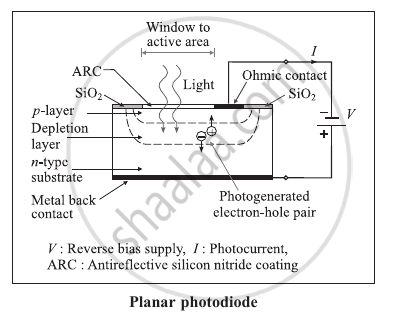Advertisements
Advertisements
Question
With a neat labelled diagram, explain the working of a photodiode. Calculate the wavelength in angstrom at which the emissive power is maximum for a blackbody heated to 3727 °C.
Solution
In response to photons and other high-energy particles, a photodiode is a type of reverse-biased pn-junction diode used for specific purposes. It produces charge carriers and increases the external circuit's photocurrent in direct proportion to the intensity of the incident radiation.

When a photodiode is run in reverse bias mode, the depletion region gets broader. The thermally generated minority charge carriers are the only cause of the reverse saturation current when the device is operated in the dark (zero illumination). We refer to this as the dark current.
In the depletion zone, electron-hole pairs are formed when subjected to radiation of high energy green light (hv ≥ EG) (in the near-UV to the near-IR range). These photogenerated electrons and holes are accelerated toward the n and p sides, respectively, by the electric field in the depletion layer, forming a photocurrent I in the external circuit from the p side to the n side. Reverse current increases and more charge carriers are accessible for conduction as a result of photogeneration. The photocurrent and incident light intensity are directly correlated. It is not influenced by the voltage of reverse bias.
Data: T = 3727°C = 3727 + 273 = 4000 K,
b = 2.898 × 10−3 m.K,
λm T = b
∴ The peak wavelength, `λ_m = b/T`
= `(2.898 xx 10^-3)/4000`
= 7.245 × 10−7
m = 7245 Å
